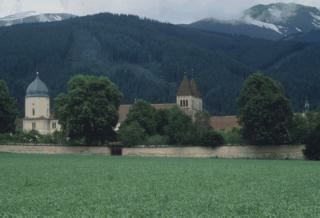
A small valley called the Pol extends north from the Mür valley not far west of Seckau Abbey. It serves as the main route from Graz to Salzburg, as a mountain pass departs the Pol to the north and connects to the neighboring Enns valley. The valley is hemmed in by the mighty Wolzer and Seckauer Tauern (mountains), which harbor many active and abandoned mines.

A fortified priory attached to Admont Abbey, adjacent to a small village of the same name. The deteriorating castle Hanfelden looms over the priory. It stands within the narrow Pol Valley along the Bretsteinbach River, which flows south to meet the Mür 10 miles away. A garrison guards both the priory and the mountain pass which leads from the Mür to the Enns valley. Magi of Rabenstein investigated demonic influence here with the monks of Admont in 1206.
A small village just 4 miles north of Unterzeiring along the Bretsteinbach river. It lies along the road from Graz to Salzburg, and on the slopes of the Polstat. A single mill with a wooden trough and many iron smithies dot the hillside, their smoke belching into the sky. The road crosses the Niedere Taurern south to north, emerging in the wide Enns valley.
A ruined castle overlooking the Pol Valley and the Mur river, not far from Unterzeiring. It is abandonded, lost in the encroaching firs, though often beggars or outlaws seek refuge from the winter in its sagging walls.
The Mur Valley extends from the Pol valley (which diverges northward past the Abbey of Seckau), eastward towards the town of Bruck. This 45-mile region is the most densely populated section of the lengthy Mur river, as the valley is lush green, with a wide expanse of rolling hills. The small village of Leoben serves as a central-location and sight of the monthly market. West of the Pol Valley, a path follows the continually narrowing Mur valley along the river upstream. For the most part, this region is ill-traveled, as the towering Gurktaler Alpen, and Niedere Tauern loom over the south and north banks of the river. Further, the valley ends near a village called Mauterndorf. Attempts to build a road from Mauterndorf to the Enns valley across the mountains persist, and if successful, will undoubtedly expand the influence of the Archbishop of Salzburg.
Seckau is one of the four diocese under the Archbishop of Salzburg (the others being Gurk, Chiemsee, and Lavant). Further, Bishop Ebehard is the liege of Rabenstein, and owns the land upon which the Covenant is built. Although he is often away attending to his Italian estates, his canons attend to the Diocese in his stead.
Built in the mid-12th Century, the Abbey's two pyramid-domed towers stand proudly over the Mur valley, each topped with huge square capitals with little decoration. The Abbey's Chapel of the Blessed Sacrament is adorned with an early-13th Century Alabaster of Venetian origin over the tabernacle - the jewel of its treasury. Nearby serfs attend the needs of the Abbey, though no 'village of Seckau' exists yet. When the Cathedral is comlpeted in Graz, the Bishop's seat will be situated there instead of the Abbey itself.

*As the vassals of Seckau, Rabenstein has the right to bear arms, and flies the banner of the Bishop from their ramparts. They are negotiating with the canons about an endeavor to establish a toll along the road from Graz to Bruck.
The oldest Benedictine monastery in all of Austria, founded in 1000 AD, it lies a few miles west of Landskron castle. Although the buildings are only squat, humbly built stone, they sit amidst a grove of beautiful chestnut and oak trees. Abbot Jurkis, a wheezing old man, keeps his brethren well-insulated from the baudy markets of Leoben each month.
Julian of Rabenstein recently helped Jurkis return his monastery to its desired solitude (see the adventure summary Mist of the Ancients), and as a result, coupled with its ties to Seckau Abbey, Rabenstein is generally well-regarded here.
A market town located 10 miles upstream from Bruck (and 43 miles from Graz) along the Mauterndorf road. It is a common meeting point for miners from the Eisenertz and peasants of the Mur Valley. On the first Saturday of each month the population doubles, weather permitting for the market. Due to this market, the town is growing rapidly, and may surpass Bruck. The Maria Waasen Church has just been completed, with modern Gothic windows emulating the style of Paris. Just outside of town is the Monestary of Goss, founded in 1100 by Benedictines who prosper with the growth of the town.
A very small settlement which surrounds a small wooden fort in a rocky cleft on route from Bruck to Seewiesen. Originally intended as a military outpost to guard to road, the heavy settlement and protection of the nearby Bruck has led to the surrounding wattle-and-daub huts. Only 2 miles northeast of Bruck, though the river is not visible from here.
This page last modified on 2/8/98.
Comments to madirishman@mad-irishman.net
Return to the Rabenstein home page